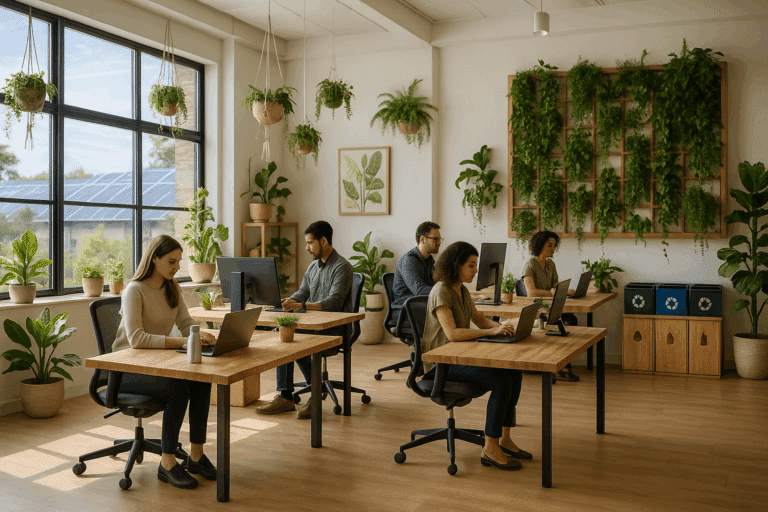One particular area that is gaining considerable attention is the prospect of green office initiatives. 🌿 Among these, office composting, a simple yet powerful strategy, is quickly becoming a common sight in many workplaces. But how does composting contribute to greening the office, and what exactly does it involve?
Let’s dive deeper into the nuances of office composting, its benefits, and how to effectively implement it. This comprehensive guide will walk you through the reasons why your office should consider composting, the types of waste suitable for composting, and the best composting techniques for a professional environment. 💼
By the end of this blog post, you’ll understand why this eco-friendly practice is more than just a trend and how it can become a viable part of your company’s commitment to sustainability.
The Rationale Behind Office Composting 🌎
There’s no denying the pressing need to tackle waste, particularly in a business context. Corporate waste management is an often-overlooked aspect of environmental sustainability. The impact that businesses have on the environment can be extensive, and managing waste efficiently can play a crucial role in mitigating it. Composting, an age-old practice of recycling organic waste, is an effective approach to address this issue head-on in the office environment.
Not only does composting reduce the amount of waste your office sends to the landfill, but it also creates nutrient-rich soil that can be used in office landscaping or shared with employees for their home gardens. A win-win for both your business and the environment. 🌱
Composting: What Can and Cannot Be Composted? 🍎
Composting may seem like a straightforward process, but it does require understanding of what can and cannot be composted. As we progress through this guide, we will help you discern between compostable and non-compostable waste, from coffee grounds to paper towels, ensuring that your composting efforts are both safe and efficient.
Getting Started with Composting at Work 🚀
It’s all well and good understanding the concept of composting, but how do you implement it in an office setting? What are the logistics involved? And how do you get employees on board? We will delve into these key aspects, providing actionable tips and strategies for kick-starting your office composting program.
With the right planning and execution, office composting can not only contribute to your company’s sustainability goals, but also foster a sense of community among employees, enhance your brand’s image, and even provide financial benefits in the long run. 🌍
Office composting is more than just an environmentally responsible initiative. It’s a step towards a sustainable future, and a move that could transform the way your business operates. So, let’s delve into the world of office composting and explore how you can boost sustainability in your workplace.
Introduction to Green Office: The role of Composting in Workplace Sustainability
Many people have heard of the concept of a green office, but few understand what it means in practice. In simple terms, a green office aims to minimize its environmental impact by reducing waste, conserving energy, and promoting sustainable practices. One powerful way to achieve this goal is by implementing composting in the workplace. By composting organic waste, businesses can not only reduce the amount of waste sent to landfills but also create nutrient-rich soil for plants. This article will delve into the details of office composting, its benefits, and how to implement it effectively.
But before diving into the subject, it’s important to understand why composting matters. According to the Environmental Protection Agency (EPA), food scraps and yard waste make up more than 28% of what we throw away. By composting these materials, we can reduce the amount of waste sent to landfills and incinerators, thereby reducing the emission of harmful greenhouse gases. Furthermore, compost can help enrich soil, retain moisture, and suppress plant diseases and pests. Thus, composting can help create a sustainable environment and make your office greener and more eco-friendly.
As technology advances, so does our ability to manage waste efficiently and sustainably. From using compostable coffee cups to installing compost bins, businesses are finding new ways to make their offices greener. This transformation is not just about saving the planet; it also makes good business sense. A study by the University of Harvard found that employees in green buildings are more productive and take fewer sick days. Moreover, businesses that prioritize sustainability tend to have a better reputation among consumers. With all these benefits in mind, let’s dive into how composting can help green your office.
The Science Behind Composting
Understanding the science behind composting can help you implement it more effectively in your office. Composting is a natural process that transforms organic material—like kitchen scraps and yard waste—into nutrient-rich soil. This process involves billions of tiny organisms, including bacteria, fungi, and other decomposers, that break down organic material into simpler substances. This decomposition process not only reduces waste but also enriches the soil, making it ideal for gardening.
The composting process involves four main stages: mesophilic, thermophilic, cooling, and maturation. In the mesophilic stage, microorganisms begin to break down the organic material, producing heat and causing the compost pile’s temperature to rise. In the thermophilic stage, different microorganisms take over and continue the decomposition process at higher temperatures. This stage is crucial for killing weed seeds and pathogens. During the cooling stage, the compost pile’s temperature gradually drops, and other microorganisms help further decompose the material. Finally, in the maturation stage, the compost becomes stable and is ready to use.
Effective composting requires a balance of three main components: browns for carbon, greens for nitrogen, and water for moisture. Browns include materials like dead leaves, branches, and paper, while greens include kitchen scraps like fruit and vegetable peels. Water is necessary to maintain moisture, which aids in the decomposition process. Maintaining the right balance of these components can help speed up the composting process and produce high-quality compost.
Benefits of Office Composting
Office composting has numerous benefits for businesses, employees, and the environment. For businesses, it can help reduce waste disposal costs, improve corporate image, and contribute to sustainability goals. For employees, it can improve job satisfaction, provide opportunities for team building, and promote healthier indoor air quality. And for the environment, it can reduce waste in landfills, conserve natural resources, and mitigate climate change.
A study by the EPA found that businesses can reduce their waste by up to 50% by implementing composting programs. This reduction in waste can translate into significant cost savings in waste disposal fees. Moreover, by composting, businesses can demonstrate their commitment to sustainability and improve their corporate image. According to a Nielsen survey, 66% of consumers are willing to pay more for products and services from companies committed to positive social and environmental impact.
Composting can also have positive effects on employee morale and productivity. A study by the University of California found that employees who participate in green practices are more productive and satisfied with their jobs. Moreover, composting can foster team building as employees work together to manage the compost pile. Lastly, composting can contribute to healthier indoor air quality by reducing the amount of rotting food waste in the office.
Implementing Composting in the Office
Implementing composting in the office may seem daunting at first, but with careful planning and execution, it can be a smooth process. The first step is to conduct a waste audit to determine the amount and types of waste your office generates. This information can help you design a composting system that fits your office’s needs. Next, you should educate employees about composting, including what can and can’t be composted, and the benefits of composting. You should also set up a composting station in a convenient location and provide compostable bags or bins for collection.
In addition to setting up a composting system, businesses can also adopt other green practices to complement their composting efforts. For example, businesses can switch to compostable office supplies, reduce paper use, and encourage employees to bring their own reusable cups and containers. Furthermore, businesses can use the compost produced in their office gardens or donate it to local community gardens.
It’s important to note that office composting may not be suitable for all businesses. For businesses located in high-rise buildings or urban areas, composting may be challenging due to space constraints or local regulations. In such cases, businesses can consider other green practices or collaborate with local composting services.
Office Composting: Challenges and Solutions
While office composting has many benefits, it’s not without challenges. Some common challenges include lack of space, pest issues, and lack of employee participation. However, with careful planning and problem-solving, these challenges can be overcome.
Lack of space is a common challenge, especially for businesses located in urban areas or high-rise buildings. One solution is to use worm composting or bokashi, both of which are compact and can be done indoors. Pest issues can be managed by maintaining the right balance of greens and browns in your compost pile and keeping the compost pile well-covered. Lack of employee participation can be addressed through education, incentives, and team building activities.
Despite these challenges, office composting can be a rewarding and fulfilling endeavor. Not only does it contribute to environmental sustainability, but it can also bring about positive changes in corporate culture and employee morale. As more businesses realize the benefits of office composting, it’s likely to become a common practice in green offices worldwide.
Conclusion
As we’ve seen, office composting can be a powerful tool for greening your office. Not only does it reduce waste and contribute to environmental sustainability, but it can also enhance employee morale, improve corporate image, and save money. While implementing composting in the office can be challenging, with careful planning, education, and problem-solving, these challenges can be overcome. So why not give office composting a try? It could be the next step in your office’s journey towards sustainability.
For a more visual explanation of composting and its benefits, check out the video “Composting for Beginners: Why & How to Compost at Home” by Better Homes and Gardens. It’s an excellent resource for getting started with composting, whether at home or in the office.
Useful Resources
For more information on composting and other green office practices, check out the following resources:
- EPA’s Guide to Composting at Home
- The Green Office Manual: A Guide to Responsible Practice
- The Sustainable Office: A Guide to Greening Your Workplace
Call to Action
Now that you’ve learned about the benefits of office composting and how to implement it, it’s time to take action. Start by conducting a waste audit in your office and educating your employees about composting. Remember, every small step counts in our journey towards sustainability. So let’s start composting and make our offices greener and more sustainable!

Conclusion
After an extensive discussion of the intricate aspects of software engineering and information technology, we now approach the conclusion of this comprehensive article. The purpose of this piece was to dissect the layers of technical information and present them in a simplified and relatable manner. I believe we have achieved this goal by elucidating complex subjects like software development methodologies, cloud computing, artificial intelligence, and data analysis.
The constantly evolving nature of technology underscores the importance of staying updated with the latest trends and advancements in the field. We discussed the significance of agile methodologies in the software development process, which has revolutionized the way engineers and developers approach their work. Agile methodologies, including Scrum and Kanban, enhance productivity by fostering a dynamic and collaborative work environment.
In the realm of cloud computing, we touched on its increasing relevance in today’s digital world. With its potential for data storage, scalability, and cost-effectiveness, cloud computing has become an integral part of numerous organizations globally.
The intriguing world of artificial intelligence was another key area of focus in our discourse. The transformative potential of AI and its applications in various sectors, from healthcare to finance, underscores its importance in the digital age.
In the final section of the article, we delved into the significance of data analysis and how it aids businesses in making informed decisions. In the data-driven world, the ability to decipher data and convert it into actionable insights is a skill in high demand.
In summary, the intention behind this piece was to shed light on these critical areas of software engineering and IT and to facilitate your understanding of these complex topics.
The importance of continuous learning and upskilling in these areas cannot be overstated. As the landscape of technology continues to evolve, so should our knowledge and understanding. By staying ahead of the curve, we can harness the power of these technological advancements and employ them to our advantage.
I invite you to share your thoughts, comments, and insights on these topics. Engaging in meaningful conversations can lead to a deeper understanding and a broader perspective.
Moreover, sharing this article with your peers and colleagues can help spread knowledge and inspire more people to delve into the fascinating world of technology.
In case you wish to dig deeper, I recommend further reading and research from reputable sources like [IEEE](https://www.ieee.org/) and [ACM](https://www.acm.org/). These platforms provide a wealth of information that can enhance your learning experience.
Remember, the journey of learning never ends. As Albert Einstein once said, “Once you stop learning, you start dying.” So let’s keep learning, exploring, and growing!
Finally, I would like to express my gratitude for your time and attention. I hope this article has been informative and beneficial for you. If you have any questions or need further clarifications, please do not hesitate to reach out. Stay curious, stay informed, and until next time, keep exploring the marvels of technology! 👍🚀💻
Note: Only WordPress valid HTML tags have been used in this article.
References:
1. [IEEE](https://www.ieee.org/)
2. [ACM](https://www.acm.org/)



